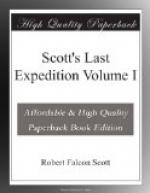The wind dropped at night.
Sunday, May 21.—Observed as usual. It blew from the north in the morning. Had an idea to go to Cape Royds this evening, but it was reported that the open water reached to the Barne Glacier, and last night my own observation seemed to confirm this.
This afternoon I started out for the open water. I found the ice solid off the Barne Glacier tongue, but always ahead of me a dark horizon as though I was within a very short distance of its edge. I held on with this appearance still holding up to C. Barne itself and then past that Cape and half way between it and C. Royds. This was far enough to make it evident that the ice was continuous to C. Royds, and has been so for a long time. Under these circumstances the continual appearance of open water to the north is most extraordinary and quite inexplicable.
Have had some very interesting discussions with Wilson, Wright, and Taylor on the ice formations to the west. How to account for the marine organisms found on the weathered glacier ice north of the Koettlitz Glacier? We have been elaborating a theory under which this ice had once a negative buoyancy due to the morainic material on top and in the lower layers of the ice mass, and had subsequently floated when the greater amount of this material had weathered out.
Have arranged to go to C. Royds to-morrow.
The temperatures have sunk very steadily this year; for a long time they hung about zero, then for a considerable interval remained about -10 deg.; now they are down in the minus twenties, with signs of falling (to-day -24 deg.).
Bowers’ meteorological stations have been amusingly named Archibald, Bertram, Clarence—they are entered by the initial letter, but spoken of by full title.
To-night we had a glorious auroral display—quite the most brilliant I have seen. At one time the sky from N.N.W. to S.S.E. as high as the zenith was massed with arches, band, and curtains, always in rapid movement. The waving curtains were especially fascinating—a wave of bright light would start at one end and run along to the other, or a patch of brighter light would spread as if to reinforce the failing light of the curtain.
Auroral Notes
The auroral light is of a palish green colour, but we now see distinctly a red flush preceding the motion of any bright part.
The green ghostly light seems suddenly to spring to life with rosy blushes. There is infinite suggestion in this phenomenon, and in that lies its charm; the suggestion of life, form, colour and movement never less than evanescent, mysterious,—no reality. It is the language of mystic signs and portents—the inspiration of the gods—wholly spiritual—divine signalling. Remindful of superstition, provocative of imagination. Might not the inhabitants of some other world (Mars) controlling mighty forces thus surround our globe with fiery symbols, a golden writing which we have not the key to decipher?




